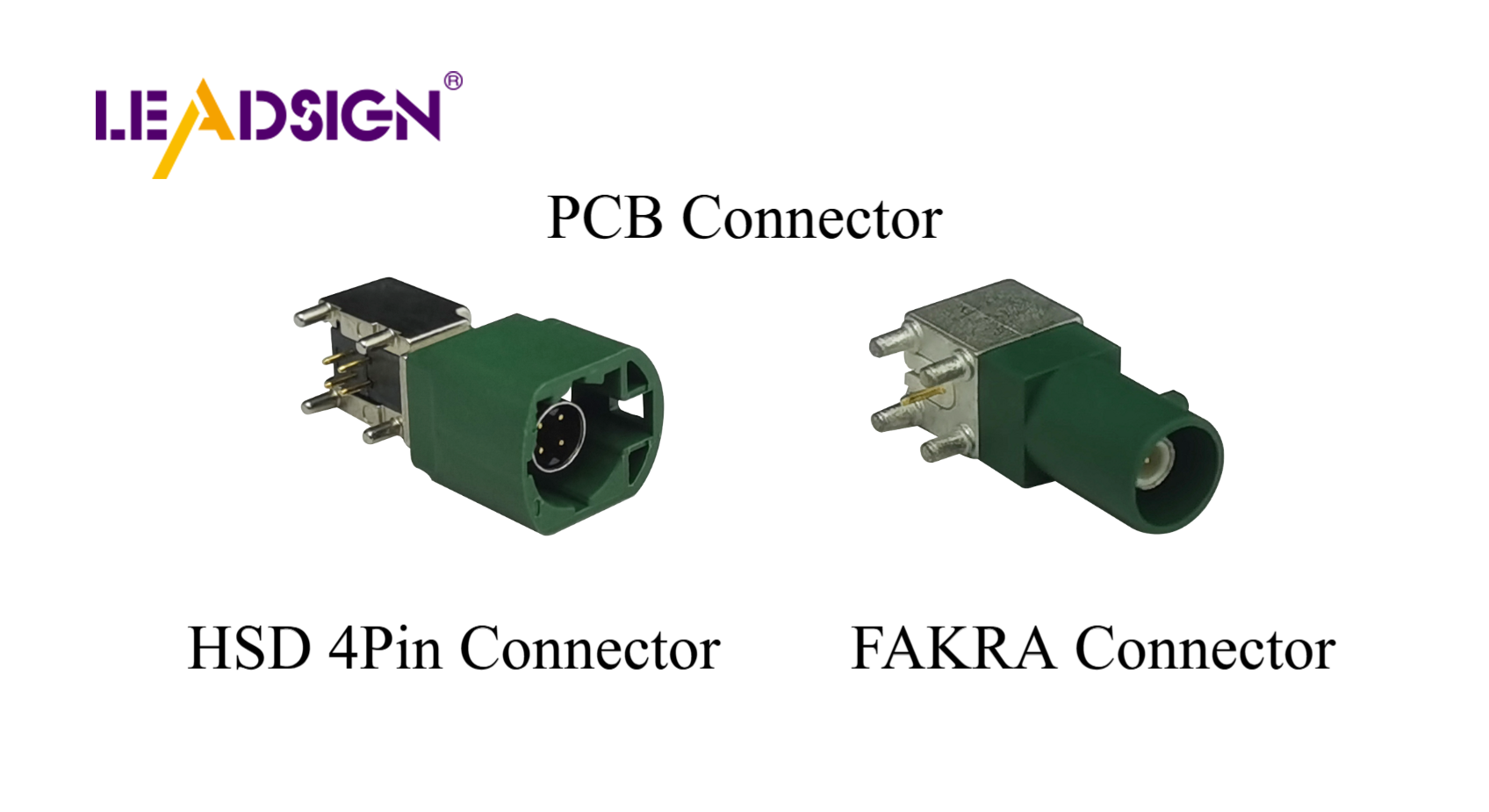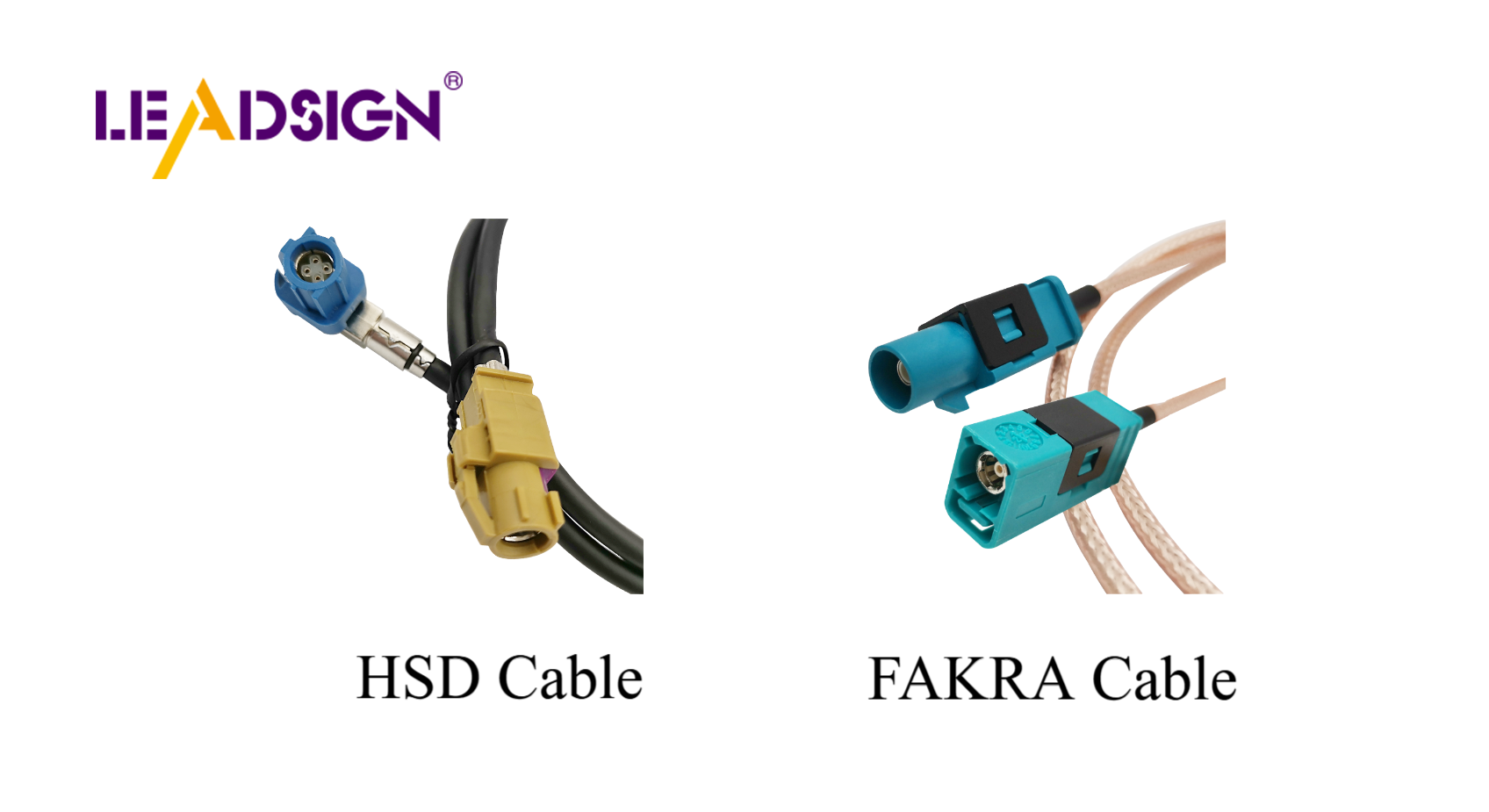Types of Wire Connectors Automotive: HSD vs FAKRA

Comparing HSD and FAKRA Automotive Connectors
Explore the differences between HSD and FAKRA connectors for automotive applications.
Features | HSD | FAKRA |
|---|---|---|
Data Transmission | Fast data transfer for car systems | RF signal transmission for GPS and radio |
Frequency Range | Supports USB and Ethernet | Handles up to 6 GHz frequencies |
Design & Size | Small with coding systems | Larger with color-coded housings |
Interference Protection | Blocks interference for clear data | Focuses on protecting RF signals |
Connector Compatibility | Works with USB and Ethernet | Plug-and-play for RF systems |
Applications | Infotainment and digital networks | GPS, radio, and satellite systems |
Modern cars utilize various automotive electrical connectors types to ensure systems operate efficiently. These systems encompass infotainment, navigation, and safety features. HSD connectors facilitate rapid data transmission between devices, while FAKRA connectors excel in transmitting RF signals such as GPS and radio. Understanding these automotive electrical connectors types aids in selecting the appropriate connector, ensuring your car functions reliably and performs at its best.
Key Takeaways
HSD connectors are essential for high-speed data transmission in automotive systems, making them ideal for infotainment and safety applications.
FAKRA connectors excel in transmitting RF signals, crucial for GPS, radio, and satellite communications in vehicles.
Choosing the right connector—HSD for fast data and FAKRA for stable RF signals—ensures optimal performance of your car's electronic systems.
Both HSD and FAKRA connectors feature robust designs with locking mechanisms to prevent incorrect connections and enhance reliability.
Understanding the specific applications of each connector helps in making informed decisions for automotive wiring needs.
HSD connectors support various data protocols like USB and Ethernet, while FAKRA connectors are designed for high-frequency telematics.
Proper installation and selection of connectors can significantly improve the functionality and reliability of modern automotive technologies.
Understanding Automotive Electrical Connectors Types: HSD and FAKRA

What Are HSD Connectors?
Definition and purpose of HSD connectors.
HSD connectors stand for High-Speed Data connectors. They are made to transfer data quickly in cars. These connectors help different car parts communicate smoothly. This makes them important for modern car systems. They are mainly used for fast data transfer. This is needed for things like videos, images, and entertainment systems.
Key features of HSD connectors, including high-speed data transmission and shielding.
HSD connectors are special because they send data fast and keep signals clear. They have strong shielding to block interference from other signals. This helps them work well even in tough conditions. Some key features are:
Primary and secondary locks to keep connections secure.
High coding efficiency to avoid wrong connections.
They work with USB 1.0, 2.0, 3.0, Ethernet, and LVDS systems.
These features make HSD connectors very useful for car systems needing speed and accuracy.
Common applications of HSD connectors in automotive systems.
HSD connectors are used in many automotive applications. You can find them in:
Infotainment systems for playing music and videos.
Advanced Driver-Assistance Systems (ADAS) for cameras and sensors.
Digital networks to connect car parts smoothly.
Their ability to send data fast makes them great for modern car technology.
What Are FAKRA Connectors?
Definition and purpose of FAKRA connectors.
FAKRA connectors are special connectors made for cars. They send RF signals like GPS, radio, and satellite signals. Their job is to connect car systems in a reliable way. They provide a standard way to link electronic parts in vehicles.
Key features of FAKRA connectors, such as RF signal transmission and robust design.
FAKRA connectors are strong and good at sending RF signals. Important features include:
50 Ω impedance and up to 6 GHz frequency for stable signals.
Color-coded housings and keys to avoid wrong connections.
Primary and secondary locks for secure assembly.
They can handle extreme temperatures from -40°C to +105°C.
These features make FAKRA connectors perfect for car systems needing strong RF signals.
Common applications of FAKRA connectors in automotive systems.
FAKRA connectors are used in automotive applications that need RF signals. You’ll see them in:
GPS and navigation systems for accurate directions.
Radio antennas for clear sound.
Satellite systems for entertainment and communication.
Their strong build and good performance make them essential for today’s car electronics.
Key Differences Between HSD and FAKRA Connectors
Functionality
Data transmission capabilities: high-speed data vs. RF signals.
HSD connectors send data very fast. They are great for systems like car entertainment and driver-assistance. These connectors help devices share information quickly and smoothly. FAKRA connectors, however, send radio signals like GPS and satellite. They are best for systems needing stable and clear signals. HSD focuses on speed, while FAKRA ensures signal strength.
Frequency range and signal type.
HSD connectors work with frequencies for fast data networks. They support USB and Ethernet for smooth data transfer. FAKRA connectors handle higher frequencies, up to 6 GHz. This helps them send radio signals well. HSD connectors manage digital data, while FAKRA handles radio signals.
Design and Construction
Physical design, size, and coding systems.
HSD connectors are small and prevent wrong connections with coding. FAKRA connectors are bigger and stronger. They use color codes and keys to avoid mistakes. Their size fits their tough design.
Shielding and interference protection.
HSD connectors block interference to keep data clear. They work well in noisy environments. FAKRA connectors also block interference but focus on radio signals. Both protect against interference but for different uses.
Connector compatibility and installation requirements.
HSD connectors work with systems like USB and Ethernet. They need careful setup for good performance. FAKRA connectors are easier to install and work with GPS and radios. They are plug-and-play for RF systems.
Applications
Specific automotive systems where each connector is used.
HSD connectors are used in car entertainment, cameras, and networks. They help parts share data quickly. FAKRA connectors are used in GPS, radios, and satellites. Each connector fits different car systems.
Suitability for infotainment, cameras, GPS, and other technologies.
HSD connectors are perfect for car entertainment and cameras. They send data fast for videos and safety systems. FAKRA connectors are better for GPS and radios. Their strong design keeps signals clear. Choose the right one based on your car's needs.
Uses of HSD and FAKRA Connectors in Cars
HSD Connectors in Cars
Role in car entertainment systems like music and videos.
HSD connectors are important for car entertainment systems. They help devices share data quickly and smoothly. When you watch videos or play music, these connectors keep everything running without stopping. They handle lots of data, making them great for high-quality entertainment.
Use in safety systems like cameras and sensors.
HSD connectors are key for safety systems like cameras and sensors. They send data fast to the car's main system. For example, when using a backup camera, these connectors send the video instantly. This quick action helps keep you safe and improves driving.
Connection with fast data networks in cars.
HSD connectors work well with fast data networks in cars. They support systems like USB and Ethernet for smooth communication. This helps your car's systems, like navigation and diagnostics, work together. Stable connections make your car perform better.
FAKRA Connectors in Cars
Role in GPS and navigation systems.
FAKRA connectors are crucial for GPS and navigation systems. They send signals accurately, helping track locations. When using your car's GPS, these connectors ensure the antenna works well. This helps you get to your destination without problems.
Use in satellite radio and antennas.
Satellite radio and antennas rely on FAKRA connectors. They send signals clearly, giving you good sound quality. Whether listening to music or news, these connectors keep the audio steady. Their strong design makes them last a long time.
Connection with RF-based systems in cars.
FAKRA connectors work with RF-based systems like Bluetooth and keyless entry. They connect parts to make these systems work smoothly. For example, when unlocking your car with a remote, these connectors help the signal reach the car. This makes modern car features more convenient and useful.
Knowing the difference between HSD and FAKRA connectors is helpful. HSD connectors send data quickly, great for entertainment and safety systems. FAKRA connectors send radio signals, perfect for GPS, radio, and satellites.
Think about your system's needs when picking a connector. HSD connectors are best for fast data and blocking interference. FAKRA connectors are better for high-frequency uses and easy setup. Choosing the right one keeps your car working well and reliably.
FAQ
What are the features of FAKRA connectors?
FAKRA connectors are strong and very adaptable. They have color-coded covers and special key shapes to stop wrong connections. Made from tough materials, they can handle harsh car conditions. These connectors follow FAKRA standard specifications, making them reliable for many uses.
How do FAKRA connectors differ from HSD connectors?
The main difference is in what they do. FAKRA connectors send RF signals, perfect for high frequency telematic applications like GPS and satellite radio. HSD connectors send data fast, great for infotainment and driver-assistance systems. Their cable connection differences show their unique jobs, with FAKRA focusing on signal strength and HSD on speed.
What are the applications of FAKRA and HSD connectors in vehicles?
Both connectors are important in modern cars. FAKRA connectors help with automotive communications like GPS, satellite radio, and Bluetooth. HSD connectors improve infotainment, safety, and self-driving systems by sending data quickly. Together, they make cars work better and save money.
Why are FAKRA connectors essential for automotive communications?
FAKRA connectors keep RF signals stable and reliable, which is key for automotive communications. They link systems like GPS, radios, and keyless entry for smooth operation. Their strong locks and FAKRA standard specifications make them a must-have for today’s cars.
What are the benefits of using different types of FAKRA connectors?
The different types of FAKRA connectors meet various car needs. Straight, angled, and waterproof designs fit different setups. They work with systems like GPS and infotainment for better performance. These types save space and are easy to use.
How do HSD connectors enhance automotive systems?
HSD connectors make car systems better by sending data fast and accurately. They help infotainment systems play music and videos smoothly. In safety systems, they quickly share data from cameras and sensors. Their speed makes them vital for advanced car tech.
What makes FAKRA connectors suitable for high frequency telematic applications?
FAKRA connectors are great for high frequency telematic applications because of their 50 Ω impedance and up to 6 GHz frequency. These features keep RF signals clear and stable. Their strong build and secure locks make them work well in tough car conditions.
Can FAKRA and HSD connectors be used together in vehicles?
Yes, FAKRA and HSD connectors often work together in cars. FAKRA connectors handle RF signals for GPS and satellites. HSD connectors manage fast data for infotainment and safety systems. Together, they create a smooth network for modern car tech.
How do FAKRA connectors improve vehicle reliability?
FAKRA connectors make cars more reliable by giving strong and stable connections. Their tough design lasts in extreme conditions. By keeping RF signals steady, they help systems like navigation, communication, and entertainment work well.
What should you consider when choosing between FAKRA and HSD connectors?
Think about your system’s needs when picking between FAKRA and HSD connectors. FAKRA connectors are cheap and easy to install, great for RF systems like GPS and radios. HSD connectors send data fast and block interference, perfect for infotainment and safety. Choose based on your car’s requirements.
See Also
Why Fakra Connectors Matter in Automotive Engineering
Uncovering Advantages of Fakra Connectors for Vehicles
Understanding HSD Connectors in Automotive Applications

